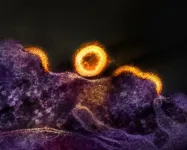(Press-News.org) GAINESVILLE, Fla. — University of Florida Health scientists exploring how combinations of antibiotics can fight resistant bacteria have been awarded an $11.8 million grant for work that could help save the tens of thousands of lives lost yearly to infections that are increasingly plaguing humanity.
The National Institutes of Health, or NIH, grant to the UF College of Medicine and the UF College of Pharmacy will support scientists working to uncover the mechanics of how bacteria and antibiotics interact, down to the molecular level.
That mechanistic knowledge has become crucial as bacteria become ever-more resistant to antibiotics. Few pharmaceutical companies are developing new antibiotics, leaving scientists to find novel methods to make older drugs more effective when used in combination.
Accordingly, the National Institute of Allergy and Infectious Diseases, under the NIH, solicited competitive proposals in a “call to arms” to address the crisis, UF Health researchers said.
“It’s very clear on these serious infections with antibiotic-resistant bacteria that monotherapy cannot work,” said Jürgen Bulitta, Ph.D., a co-principal investigator on the project at the UF Research and Academic Center at Lake Nona, Orlando. “Using one antibiotic at a time, you cannot win. You must tag-team with more than one drug to have any chance against serious infections.”
The hope is to “dial in” these antibiotics using newfound insight from the laboratory. It’s like understanding an enemy’s weaknesses to form a battle plan that takes advantage of those chinks in the armor. What receptors on bacteria are best targeted by antibiotics? What precise dosages in a drug cocktail will kill a bacterial population without resistant stragglers surviving to multiply?
Bulitta and UF Health researcher and co-principal investigator George L. Drusano, M.D., a professor and director of the UF College of Medicine’s Institute of Therapeutic Innovation, will examine two of the deadliest resistant bacteria, Acinetobacter baumannii and Klebsiella pneumoniae.
The bacteria, sometimes called “superbugs,” are often found in hospitals, usually infecting patients with weakened immune systems. They are adept at finding genetic adaptations to elude the drugs hunting them.
“These bacteria are not only multi-resistant to antibiotics, they’re also hypervirulent,” said Drusano. “They have turned into really nasty, nasty bugs that wreak havoc on patients’ bodies and too often kill them. We have some great antibiotics. But we need to optimize them and find new approaches that will cure people and get them out of the hospital.”
The researchers are using advanced computer modeling techniques and in vitro (outside-the-body) testing, such as a relatively new method called the hollow fiber infection model.
This technique uses a collection of hollow fibers 200 microns in diameter — roughly twice the thickness of a human hair — to culture cells and bacteria. The method reproduces what happens in the human body and helps scientists measure how bacteria respond to drugs and develop resistance.
These bacteria reproduce and evolve in rapid cycles of life and death as short as 20 to 30 minutes, and generations of reproduction are achieved in days. A severe infection might generate billions of bacteria in the lungs, making it highly probable that a beneficial bacterial adaptation will get a toehold, defanging an antibiotic.
Even with a patient’s natural immune defense and antibiotics, Bulitta said, bacteria are reproducing so rapidly, “it’s a near certainty you will still have 100 to 1,000 resistant bacteria remaining in severe lung infections.”
Multidrug therapy seeks to reduce the population of that bacteria with one antibiotic regimen, then hitting it with a second or third using different drugs. This can reduce bacterial numbers before the superbugs can again adapt new protections.
“It’s a game of cat and mouse,” said Bulitta, a professor and The Perry E. Foote Eminent Scholar Chair in the UF College of Pharmacy’s Department of Pharmacotherapy and Translational Research.
UF Health is leading this multicenter investigation. Other participants include researchers at Case Western Reserve University in Cleveland; the Children’s Hospital of Los Angeles, Monash University in Australia; St. Jude’s Children’s Research Hospital in Memphis; Northern Arizona University in Flagstaff, Arizona; and the University of Central Florida in Orlando.
GAINESVILLE, Fla. — University of Florida Health scientists exploring how combinations of antibiotics can fight resistant bacteria have been awarded an $11.8 million grant for work that could help save the tens of thousands of lives lost yearly to infections that are increasingly plaguing humanity.
The National Institutes of Health, or NIH, grant to the UF College of Medicine and the UF College of Pharmacy will support scientists working to uncover the mechanics of how bacteria and antibiotics interact, down to the molecular level.
That mechanistic knowledge has become crucial as bacteria become ever-more resistant to antibiotics. Few pharmaceutical companies are developing new antibiotics, leaving scientists to find novel methods to make older drugs more effective when used in combination.
Accordingly, the National Institute of Allergy and Infectious Diseases, under the NIH, solicited competitive proposals in a “call to arms” to address the crisis, UF Health researchers said.
“It’s very clear on these serious infections with antibiotic-resistant bacteria that monotherapy cannot work,” said Jürgen Bulitta, Ph.D., a co-principal investigator on the project at the UF Research and Academic Center at Lake Nona, Orlando. “Using one antibiotic at a time, you cannot win. You must tag-team with more than one drug to have any chance against serious infections.”
The hope is to “dial in” these antibiotics using newfound insight from the laboratory. It’s like understanding an enemy’s weaknesses to form a battle plan that takes advantage of those chinks in the armor. What receptors on bacteria are best targeted by antibiotics? What precise dosages in a drug cocktail will kill a bacterial population without resistant stragglers surviving to multiply?
Bulitta and UF Health researcher and co-principal investigator George L. Drusano, M.D., a professor and director of the UF College of Medicine’s Institute of Therapeutic Innovation, will examine two of the deadliest resistant bacteria, Acinetobacter baumannii and Klebsiella pneumoniae.
The bacteria, sometimes called “superbugs,” are often found in hospitals, usually infecting patients with weakened immune systems. They are adept at finding genetic adaptations to elude the drugs hunting them.
“These bacteria are not only multi-resistant to antibiotics, they’re also hypervirulent,” said Drusano. “They have turned into really nasty, nasty bugs that wreak havoc on patients’ bodies and too often kill them. We have some great antibiotics. But we need to optimize them and find new approaches that will cure people and get them out of the hospital.”
The researchers are using advanced computer modeling techniques and in vitro (outside-the-body) testing, such as a relatively new method called the hollow fiber infection model.
This technique uses a collection of hollow fibers 200 microns in diameter — roughly twice the thickness of a human hair — to culture cells and bacteria. The method reproduces what happens in the human body and helps scientists measure how bacteria respond to drugs and develop resistance.
These bacteria reproduce and evolve in rapid cycles of life and death as short as 20 to 30 minutes, and generations of reproduction are achieved in days. A severe infection might generate billions of bacteria in the lungs, making it highly probable that a beneficial bacterial adaptation will get a toehold, defanging an antibiotic.
Even with a patient’s natural immune defense and antibiotics, Bulitta said, bacteria are reproducing so rapidly, “it’s a near certainty you will still have 100 to 1,000 resistant bacteria remaining in severe lung infections.”
Multidrug therapy seeks to reduce the population of that bacteria with one antibiotic regimen, then hitting it with a second or third using different drugs. This can reduce bacterial numbers before the superbugs can again adapt new protections.
“It’s a game of cat and mouse,” said Bulitta, a professor and The Perry E. Foote Eminent Scholar Chair in the UF College of Pharmacy’s Department of Pharmacotherapy and Translational Research.
UF Health is leading this multicenter investigation. Other participants include researchers at Case Western Reserve University in Cleveland; the Children’s Hospital of Los Angeles, Monash University in Australia; St. Jude’s Children’s Research Hospital in Memphis; Northern Arizona University in Flagstaff, Arizona; and the University of Central Florida in Orlando.
END
Bolstering the fight against antibiotic-resistant bacteria
2024-10-16
ELSE PRESS RELEASES FROM THIS DATE:
Deep learning illuminates atmospheric blocking events of past, future
2024-10-16
Atmospheric blocking events are persistent, high-impact weather patterns that occur when large-scale high-pressure systems become stationary and divert the jet stream and storm tracks for days to weeks, and can be associated with record-breaking flooding or heat waves, such as in Europe in 2023. In a new study, University of Hawai‘i at Mānoa atmospheric scientist Christina Karamperidou used a deep learning model to infer the frequency of blocking events over the past 1,000 years and shed light on how future climate change may impact these significant phenomena.
“This study set out to extract a paleoweather signal from ...
Kidney transplantation among those with HIV infections shown safe and effective
2024-10-16
It is just as safe and effective for people with HIV in need of kidney transplantation to get their organ from donors who are also HIV positive as it is from donors who are not infected with the virus, a new study shows. Survival rates for organ recipients one and three years after the procedure were the same for donors with or without HIV. Also the same were risks of serious side effects, such as infection, fever, and rejection in the donated organ.
In what is the largest comparative trial of the experimental procedures since the first transplant was performed in the United States in 2016, researchers ...
Longer-term data from SWOG S1826 trial confirm nivolumab-AVD benefit in Hodgkin lymphoma
2024-10-16
In mid-2023, the SWOG S1826 phase 3 trial in advanced Hodgkin lymphoma reported highly positive primary results earlier than expected, after the trial’s second planned interim analysis found the preset threshold for efficacy had already been reached.
Now, a follow-up analysis with additional data – a median follow-up of 2.1 years – confirms the durability of those initial findings: among the 970 newly diagnosed adolescents and adults randomized to the trial, those who received a combination of nivolumab plus AVD chemotherapy (N-AVD) had a significantly lower risk of cancer progression ...
In landmark study, immunotherapy boosts survival of advanced Hodgkin lymphoma
2024-10-16
A treatment that rallies the immune system to destroy cancer raised the survival rate for advanced Hodgkin lymphoma patients to a remarkable 92 percent, suggesting a new standard therapy for the disease. The New England Journal of Medicine published the innovative clinical trial results this week.
Young people are most at risk to get Hodgkin lymphoma, an uncommon blood and immune system cancer that falls within the general category of lymphomas. With this new treatment, scientists believe they ...
Kidney transplantation between donors and recipients with HIV is safe
2024-10-16
WHAT:
Kidney transplantation from deceased donors with HIV (HIV D+) to recipients with HIV (HIV R+) was safe and comparable to kidney transplantation from donors without HIV (HIV D-) in a multicenter observational study in the United States. The clinical outcomes observed were consistent with smaller pilot studies, but this National Institutes of Health (NIH)-funded clinical trial was the first statistically powered to demonstrate noninferiority, which means that an approach being studied is as good as standard clinical practice. The results were published today ...
Brown researchers show how gut hormones control aging in flies and how it relates to human biology
2024-10-16
PROVIDENCE, R.I. [Brown University] — Biologists at Brown University have discovered how a neuropeptide hormone made in the gut of flies can control their lifespan.
The findings, published in PNAS, have implications for humans, too, the researchers say — especially as new diabetes and obesity medications based on gut hormones in the same family of the fly hormone are becoming more widespread.
For the past two decades, study author Marc Tatar, a professor of biology affiliated with the Center on the Biology of Aging at Brown University, has studied how the hormones insulin and insulin-like ...
Which clot-busting drug is tied to better recovery after stroke?
2024-10-16
EMBARGOED FOR RELEASE UNTIL 4 P.M. ET, WEDNESDAY, OCTOBER 16, 2024
MINNEAPOLIS – For people with ischemic stroke, treatment with the clot-busting drug tenecteplase is associated with a slightly higher likelihood of an excellent recovery and reduced disability three months later than the drug alteplase, according to a meta-analysis published in the October 16, 2024, online issue of Neurology®, the medical journal of the American Academy of Neurology. Researchers found that the likelihood of good recovery was similar ...
Study: breast cancer drug shows potential for rare appendix cancer
2024-10-16
Researchers at University of California San Diego School of Medicine found an FDA-approved drug used to treat breast cancer has the potential to be an effective therapeutic for a specific type of appendix cancer.
The clinical trial results, publishing in the October 16, 2024 online edition of the Journal of Clinical Oncology, showed the oral medication, known as palbociclib, stabilized tumor growth and reduced blood tumor marker levels in patients with peritoneal mucinous carcinomatosis (PMC). This form of cancer originates in the appendix and is often resistant to standard chemotherapy.
“Finding that a breast cancer drug is ...
Specific type of DNA could be a target of future cancer therapies
2024-10-16
Research published in Nature Genetics on Oct.14, by Yale Cancer Center researchers at Yale School of Medicine, found a higher concentration of a specific kind of DNA — extrachromosomal or ecDNA — in more aggressive and advanced cancers that could mark them as targets for future therapies.
Using data available from The Cancer Genome Atlas, the International Cancer Genomics Consortium, the Hartwig Medical Foundation, and the Glioma Longitudinal Analysis Consortium, the researchers considered more than 8,000 tumor samples, divided between newly diagnosed untreated tumors and those that had been through previous treatments ...
New Director of the Bates Center for the Study of the History of Nursing
2024-10-16
PHILADELPHIA (October 16, 2024) – J. Margo Brooks Carthon, PhD, RN, FAAN, the Tyson Family Endowed Term Chair for Gerontological Research; Professor of Nursing in the Department of Family and Community Health; and Associate Director of the Center for Health Outcomes and Policy Research, has been appointed the new Director of the Barbara Bates Center for the Study of the History of Nursing (Bates Center), the preeminent history of nursing research center and archive. The Bates Center amplifies the importance of the history of nursing and healthcare to the development of crafting effective health policies and strategies to improve health for all.
“The ...




